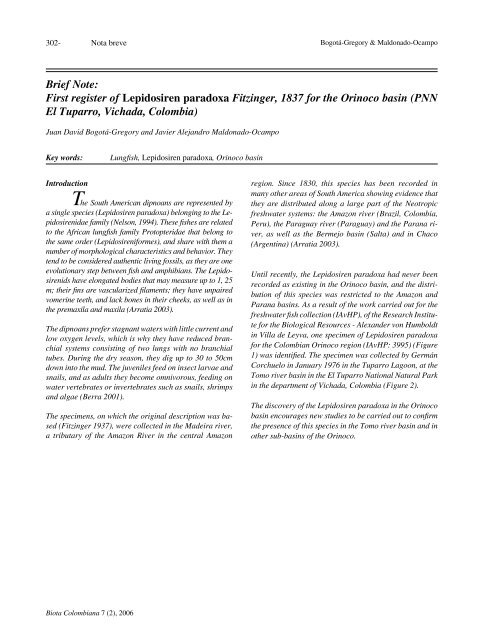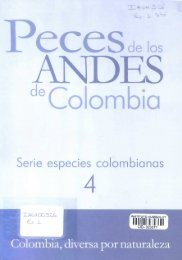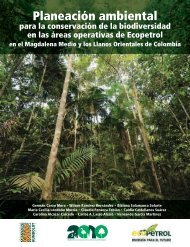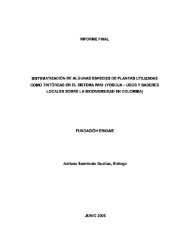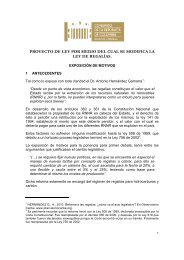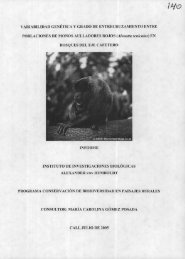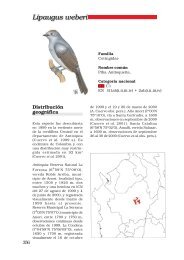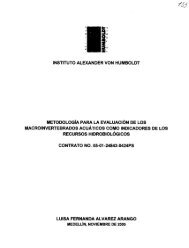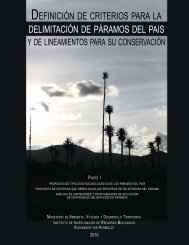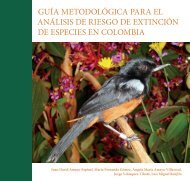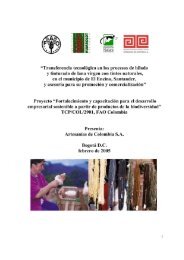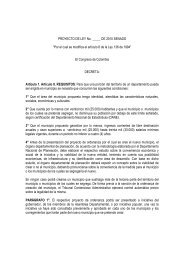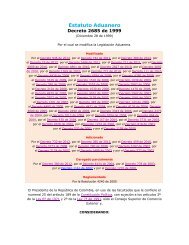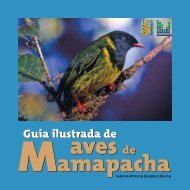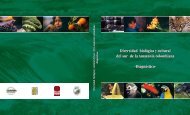biota colombiana - Instituto de Investigación de Recursos Biológicos ...
biota colombiana - Instituto de Investigación de Recursos Biológicos ...
biota colombiana - Instituto de Investigación de Recursos Biológicos ...
Create successful ePaper yourself
Turn your PDF publications into a flip-book with our unique Google optimized e-Paper software.
302- Nota breve Bogotá-Gregory & Maldonado-Ocampo<br />
Brief Note:<br />
First register of Lepidosiren paradoxa Fitzinger, 1837 for the Orinoco basin (PNN<br />
El Tuparro, Vichada, Colombia)<br />
Juan David Bogotá-Gregory and Javier Alejandro Maldonado-Ocampo<br />
Key words: Lungfish, Lepidosiren paradoxa, Orinoco basin<br />
Introduction<br />
T<br />
he South American dipnoans are represented by<br />
a single species (Lepidosiren paradoxa) belonging to the Lepidosirenidae<br />
family (Nelson, 1994). These fishes are related<br />
to the African lungfish family Protopteridae that belong to<br />
the same or<strong>de</strong>r (Lepidosireniformes), and share with them a<br />
number of morphological characteristics and behavior. They<br />
tend to be consi<strong>de</strong>red authentic living fossils, as they are one<br />
evolutionary step between fish and amphibians. The Lepidosirenids<br />
have elongated bodies that may measure up to 1, 25<br />
m; their fins are vascularized filaments; they have unpaired<br />
vomerine teeth, and lack bones in their cheeks, as well as in<br />
the premaxila and maxila (Arratia 2003).<br />
The dipnoans prefer stagnant waters with little current and<br />
low oxygen levels, which is why they have reduced branchial<br />
systems consisting of two lungs with no branchial<br />
tubes. During the dry season, they dig up to 30 to 50cm<br />
down into the mud. The juveniles feed on insect larvae and<br />
snails, and as adults they become omnivorous, feeding on<br />
water vertebrates or invertebrates such as snails, shrimps<br />
and algae (Berra 2001).<br />
The specimens, on which the original <strong>de</strong>scription was based<br />
(Fitzinger 1937), were collected in the Ma<strong>de</strong>ira river,<br />
a tributary of the Amazon River in the central Amazon<br />
Biota Colombiana 7 (2), 2006<br />
region. Since 1830, this species has been recor<strong>de</strong>d in<br />
many other areas of South America showing evi<strong>de</strong>nce that<br />
they are distributed along a large part of the Neotropic<br />
freshwater systems: the Amazon river (Brazil, Colombia,<br />
Peru), the Paraguay river (Paraguay) and the Parana river,<br />
as well as the Bermejo basin (Salta) and in Chaco<br />
(Argentina) (Arratia 2003).<br />
Until recently, the Lepidosiren paradoxa had never been<br />
recor<strong>de</strong>d as existing in the Orinoco basin, and the distribution<br />
of this species was restricted to the Amazon and<br />
Parana basins. As a result of the work carried out for the<br />
freshwater fish collection (IAvHP), of the Research Institute<br />
for the Biological Resources - Alexan<strong>de</strong>r von Humboldt<br />
in Villa <strong>de</strong> Leyva, one specimen of Lepidosiren paradoxa<br />
for the Colombian Orinoco region (IAvHP: 3995) (Figure<br />
1) was i<strong>de</strong>ntified. The specimen was collected by Germán<br />
Corchuelo in January 1976 in the Tuparro Lagoon, at the<br />
Tomo river basin in the El Tuparro National Natural Park<br />
in the <strong>de</strong>partment of Vichada, Colombia (Figure 2).<br />
The discovery of the Lepidosiren paradoxa in the Orinoco<br />
basin encourages new studies to be carried out to confirm<br />
the presence of this species in the Tomo river basin and in<br />
other sub-basins of the Orinoco.


